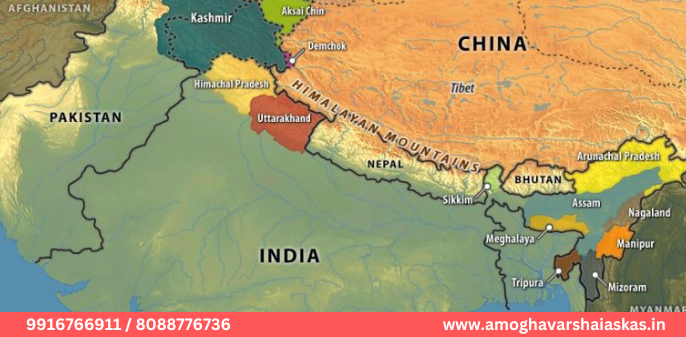India-China Border Dispute and Its Geopolitical Implications.
India-China Border Dispute.
The ongoing border dispute between India and China along the LAC has significant geopolitical ramifications that extend beyond the two nations. Both countries recently agreed on disengagement along several friction points, but the broader strategic implications are substantial. These include the influence of global players like the United States and Russia, the reshaping of regional alliances, and the evolving dynamics of the Indo-Pacific. China’s growing ambitions in Asia and its relationship with neighbouring countries make this dispute pivotal in global geopolitics.
Background of the Dispute
The India-China border dispute dates back to the 1962 Sino-Indian War, with the unresolved boundary, known as the LAC, often sparking skirmishes. The most severe escalation occurred in 2020 when Chinese troops advanced into areas traditionally patrolled by India, leading to violent clashes in the Galwan Valley. This was the most significant military confrontation in half a century. The four-year standoff de-escalated through diplomatic and military negotiations, leading to a 2024 agreement to disengage from key friction points, a development seen as a diplomatic victory for India. However, this outcome must be viewed within the larger context of global geopolitics, where multiple factors shape the stakes.

Geopolitical Importance of the LAC
The LAC stretches across strategic regions, including Ladakh, which borders China’s sensitive Xinjiang and Tibet. Control over these areas offers significant military and geopolitical advantages. For India, maintaining control over regions like the Depsang Plains and the Daulat Beg Oldie airstrip is crucial for national security, safeguarding access to the Karakoram Pass and connectivity to its northernmost territories.
For China, the LAC holds strategic value due to its proximity to the Belt and Road Initiative (BRI), particularly the China-Pakistan Economic Corridor (CPEC), essential for trade and energy security. Any Indian military advantage here poses a threat to China’s infrastructure and economic ambitions. This explains China’s aggressive posture along the LAC, seen as part of its broader strategy to assert dominance in Asia.
India’s Diplomatic and Military Victory—A Strategic Gain
India’s success in securing disengagement along the LAC is viewed as a major diplomatic and military victory, attributed to a multi-pronged approach combining military preparedness, economic leverage, and diplomacy. By refusing to normalise relations with China until the border issue was resolved, India exerted significant pressure. The timing of China’s retreat ahead of international summits like BRICS suggests that diplomatic factors also played a role.
India’s military strategy was also crucial. The occupation of the strategically important Kailash Range in 2020 allowed India to dominate the region, forcing China to negotiate. This, coupled with India’s growing infrastructure along the LAC, has given it a distinct advantage in defending its borders.
Geopolitical Implications in the Indo-Pacific Region
The India-China border dispute has broader implications for the Indo-Pacific, where strategic competition between the U.S. and China is intensifying. India has aligned itself with the U.S. and other democratic nations through the Quadrilateral Security Dialogue (Quad), which includes Australia and Japan.
China’s assertiveness along the LAC, as well as in the South China Sea and Taiwan Strait, reflects its ambition to establish regional dominance. India’s ability to stand up to China along the LAC has enhanced its credibility as a regional power, strengthening its position as a key U.S. ally and an important player in maintaining a free and open Indo-Pacific.
However, India has made it clear to the U.S. that it will not tolerate a double game. The U.S. must not try to balance its relations with India and Canada by playing both sides when false allegations against India arise, such as the recent claims about India’s involvement in a Canadian Sikh leader’s death. India expects strong and clear support from the U.S., especially as India is a critical partner in countering China’s influence in Asia. Any wavering from the U.S. or behind-the-scenes political manoeuvring to appease both Canada and India will not be acceptable to India. India, as a sovereign power, demands its allies to act with the same level of clarity and honesty that it demonstrates.
Role of Russia and the BRICS Summit
Russia, a key player in regional geopolitics, has influenced the India-China border disengagement. As a BRICS member, Russia has good relations with both India and China. During the 2023 BRICS summit, it is believed that Russia applied diplomatic pressure on China to ease tensions. Russia’s interest in maintaining stability between its two key partners is crucial, particularly as it faces increasing isolation from the West.
The BRICS summit gave China a platform to demonstrate its willingness to resolve conflicts peacefully, which may explain its decision to step back from the LAC. By easing tensions, China can focus on broader diplomatic goals, including strengthening relations with Russia and maintaining influence within BRICS. Russia benefits from stable relations between India and China, avoiding the need to choose sides.
China’s Long-Term Strategy and the Risk of Re-escalation
Despite recent disengagement, concerns remain about China’s long-term intentions. Many analysts view China’s retreat as tactical rather than a strategic defeat. China’s infrastructure along the LAC, including roads and military installations, allows it to redeploy troops quickly, raising the possibility of future re-escalation.
China’s broader ambitions remain a concern. Its aggressive actions in the South China Sea and Taiwan suggest it is unwilling to back down from territorial disputes. The disengagement along the LAC may be a temporary concession, buying time while China focuses on other strategic areas.
Moreover, China’s growing relationship with Pakistan complicates the border dispute further. China’s support for Pakistan, particularly regarding CPEC, strengthens its position along the LAC. Future conflicts between India and Pakistan could be influenced by China’s role, making the India-China border dispute a potential flashpoint for regional instability.
Economic and Strategic Leverage
India’s economic leverage over China has also played a crucial role in the disengagement. After the 2020 clashes, India imposed trade restrictions on China, significantly reducing economic ties. Combined with global economic pressures, this forced China to reconsider its stance along the LAC.
However, the long-term economic relationship between India and China remains a concern. China is India’s largest trading partner, and despite restrictions, trade continues to grow. India must balance economic interests with security concerns, ensuring it does not become overly dependent on China for critical goods and services.
Conclusion
India’s disengagement agreement with China along the LAC is a significant diplomatic and military victory, showcasing its ability to defend its territorial integrity while maintaining a strong diplomatic stance. However, this victory must be viewed within the broader context of global geopolitics.
China’s retreat is likely a tactical move rather than a strategic concession. Its long-term ambitions remain unchanged, and the risk of future conflicts along the LAC persists. India’s challenge will be to maintain its readiness while strengthening alliances with global powers like the U.S. and Russia. The India-China border dispute has far-reaching implications for the Indo-Pacific and global geopolitics. As China continues asserting dominance in Asia, India’s ability to counter this aggression will be critical in shaping future power dynamics.
Subscribe to our Youtube Channel for more Valuable Content – TheStudyias
Download the App to Subscribe to our Courses – Thestudyias
The Source’s Authority and Ownership of the Article is Claimed By THE STUDY IAS BY MANIKANT SINGH






[…] The India-China Diplomacy meeting between Indian Prime Minister Narendra Modi and Chinese President Xi Jinping at the BRICS Summit in Kazan marks a significant turning point in the evolving relationship between the two largest countries in Asia. This meeting comes after five years of strained diplomatic ties, largely due to the 2020 military standoff at the Line of Actual Control (LAC) in Ladakh, which created heightened tensions between the two nations. The meeting provides both leaders with a critical opportunity to reset their relations, repair mutual trust, and explore new avenues for cooperation and peace. It reflects a desire to move past recent conflicts and work towards stabilising their diplomatic and strategic ties for the future. […]